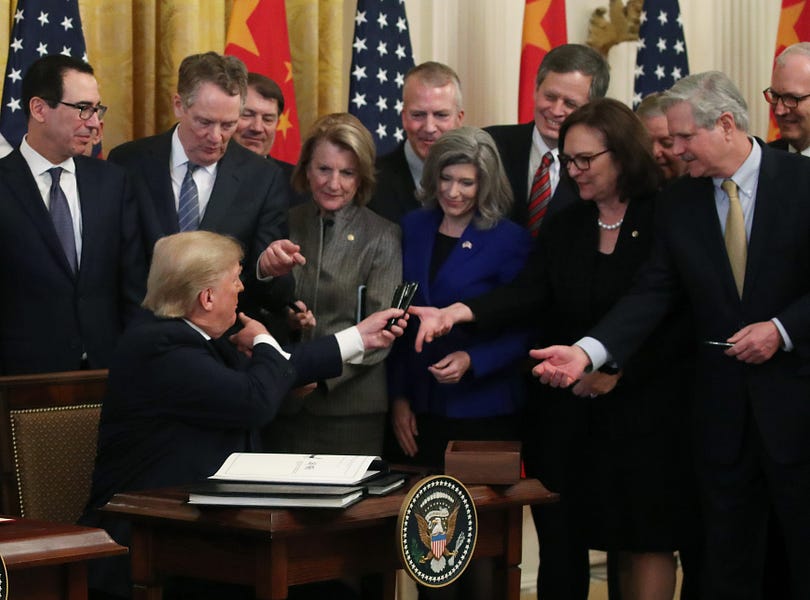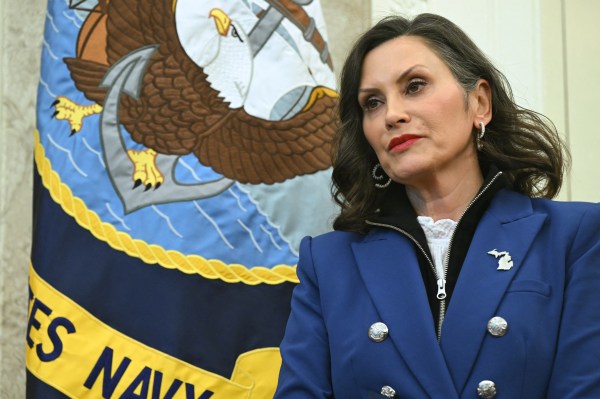The last few weeks have not been good for Donald Trump’s “Phase One” China trade deal.
First, John Bolton told the world—and the president then partially confirmed—what keen trade observers had long suspected: Trump prioritized a superficial-but-politically-useful agreement over systemic Chinese economic reforms and serious human rights concerns. Then, U.S. Trade Representative Robert Lighthizer lashed out at data showing Chinese purchases of U.S. exports to be far below the deal’s negotiated targets and historical averages, while still acknowledging that China is well behind schedule (much to Trump’s very public chagrin). Finally, senior White House adviser Peter Navarro told Fox News that, given those same data and rising U.S.-China tensions (something the Phase One deal was supposed to temper!), the agreement and any hopes for “Phase Two” were “over”—a gaffe he immediately walked back following a presidential tweet to the contrary. These and other developments have elicited some surprise from the Washington commentariat and lead many to conclude that Trump’s much-heralded agreement, while perhaps not-dead-yet, sure seems to be headed that way.
Any such surprise, however, is wholly unwarranted. While it is still possible that China somehow meets its commitments and stops acting out, the Phase One deal’s eventual collapse would be anything but surprising. In fact, the agreement was designed to fail, though perhaps not intentionally.
Before we get to that, however, some essential background: on January 15, 2020, President Trump and Chinese Vice Premier Liu He signed “Phase One” of an economic and trade agreement between the United States and China. The deal contains two main parts:
-
In terms of substantive commitments, the Phase One agreement was very one-sided: China committed to purchase fixed amounts of U.S. goods and services and to abide by various rules on agriculture, currency, financial services, and intellectual property rights protection, while the United States committed to almost nothing—not even the limited reduction in the U.S. tariffs on Chinese imports that supposedly achieved the agreement. Instead, that small tariff cut occurred separately, while the vast majority of U.S. tariffs—covering hundreds of billions of dollars in Chinese imports (essentially everything we import from China except the most politically sensitive stuff like iPhones)—remained in place, as did China’s retaliatory tariffs.
-
The Phase One deal also contains a novel enforcement mechanism: Each party may determine unilaterally 1) whether the other has violated the agreement’s terms and 2) what “proportionate” measures it will take in response, including suspending certain commitments or additional tariffs on the other country’s products. Because U.S. commitments in the deal are so minor, any U.S. retaliation under the dispute resolution provisions would almost certainly entail new tariffs. If China found that action to be illegitimate, the only response expressly authorized would be withdrawal from the Agreement itself. There is no other alternative.
Trade experts’ immediate response to the Phase One deal’s substantive commitments was surprise and mostly optimistic support. Leaving aside the principled (and warranted) economic concerns regarding the deal’s managed trade purchase commitments, the general view was that China’s substantive commitments were more extensive and detailed than expected. Most, if not all, were reforms China had already promised or wanted to do anyway, and the hardest stuff—on subsidies and state-owned enterprises, for example—was left for Phase Two, but, still, not bad (and certainly better than the initial rumors about the deal just a few weeks earlier).
One critical issue, however, was mostly overlooked at the time: Given the way the agreement was structured, the entire deal rested on China’s willingness to fulfill its commitments—and that’s always been the big problem with China. For example, there is plenty in the World Trade Organization (WTO) agreements to police Chinese financial services restrictions or intellectual property rights abuses, but China would just disregard them when convenient. Indeed, it’s this history that Lighthizer has cited to justify his unilateral approach.
The problem, however, is that the Phase One Deal does little to actually encourage Chinese compliance and might actually put the United States in a weaker position going forward than those agreements that China had already (supposedly) shirked.
Because traditional trade deals like the WTO Agreement or NAFTA have no power to force participating sovereign nations to comply with their terms, they work because parties to the agreement have three important incentives to comply voluntarily. First, because these agreements are always balanced with benefits (e.g., new market access) and “concessions” (e.g., lower tariffs) for each party, a violator might gain politically or economically from reneging on a concession but it stands to lose an agreement benefit if/when that violation occurs—a benefit to which noisy or politically powerful constituents have become accustomed.
Second, and relatedly, trade agreement parties comply because they want the other parties to do the same. Trade agreement negotiations usually involve a lot of domestic political discomfort, eased by the promise of future benefits for various core constituencies (e.g., soybean farmers). While occasional noncompliance might be forgivable (or disciplined via the aforementioned suspension of concessions), repeated noncompliance encourages similar bad behavior from other parties to the agreement and can eventually collapse the entire deal—thus ruining those hard-fought gains (and incurring the inevitable domestic blowback). Third, parties comply with their trade agreements for reputational reasons—basically to be viewed by other countries as upstanding members of the global community instead of global scofflaws. This is not just about touchy-feely poll numbers: a good international reputation can provide a nation with important economic (e.g., new trade deals or tourism) or foreign policy benefits, and a bad one can do just the opposite. These reputational effects are compounded by trade agreements’ typical use of independent arbiters to adjudicate disputes among the parties—a country’s noncompliance looks even worse when an unbiased expert confirms it misbehaved.
We see these three incentives play out in trade agreements all the time. For example, when the United States banned Mexican trucks from U.S. roads in violation of NAFTA, Mexico suspended certain NAFTA market access benefits for U.S. exporters, and this pain eventually caused the United States to relent (at least for a while). The risk of such retaliation often can deter violations from ever happening. It and the other (institutional and reputational) incentives, moreover, are frequently cited as reasons why the WTO system has proven so effective over the years, and why countries, even China, have a good record of voluntary compliance after losing a WTO dispute. Of course, these agreements aren’t perfect, but—in terms of compliance and dispute resolution, at least—they’ve held up pretty well over the years.
The U.S.-China Phase One deal, however, lacks all three of these incentives, at least in any significant capacity. First, because the agreement is so one-sided, China—the party making all of the concessions—has very little incentive to comply in order to maintain its agreement benefits (there are none) or encourage U.S. compliance (there’s nothing for the U.S. to comply with). Sure, the American market is valuable, and avoiding the deal’s collapse or potentially more tariff pain is an incentive, but most of the U.S. tariffs are still in place, and the ones that aren’t cover goods that the U.S. was, for economic, political and now public health reasons, desperately trying to avoid hitting in the first place.
Meanwhile, there are little to no reputational benefits for China to maintain the deal. U.S.-China tensions are approaching all-time highs, so noncompliance and retaliation wouldn’t likely move the needle much at this point—especially since the other team is the one calling foul. There’s also little chance that other trading partners like the EU, Australia or Japan would care if the deal fell apart. In fact, they’d probably welcome it due to the deal’s radical rejection of international legal norms and the multilateral trading system (which most countries still vocally support), as well as its beggar-thy-neighbor terms that actually harm U.S. competitors in the Chinese market. (In fact, then-EU trade honcho Celia Malmstrom criticized the agreement when it was signed, and a new economic analysis shows that the deal “would divert [Chinese] agricultural imports away from other countries” such as Australia, Canada, and Brazil.)
Thus, whether the Phase One Deal was worth all the very real damage that Trump’s tariffs (and related uncertainty) caused the U.S. economy will come down to compliance and enforcement of China’s commitments, but the deal’s structure and terms provide China with almost no incentive to comply. The United States has only one bad option to force that compliance—more tariffs on politically sensitive products (in an election year!), and the Chinese purchase commitments actually make U.S. exporters—especially those Great Patriot Farmers whom Trump needs for re-election—more dependent on the Chinese market (and, therefore, the Chinese government). So, the only party who might actually need this deal right now—the one with stuff to lose, especially in a recession—is Trump, not China.
None of this is to say that the deal will collapse, but trade agreements are designed the way they’re designed for a reason—to encourage voluntary compliance by sovereign nations with their own, often-countervailing domestic political interests. We shouldn’t be shocked when a deal specifically rejecting that design achieves the opposite result—or if Trump and his advisers, despite Chinese noncompliance, keep straining to rescue it.
Photograph by Mark Wilson/Getty Images.







Please note that we at The Dispatch hold ourselves, our work, and our commenters to a higher standard than other places on the internet. We welcome comments that foster genuine debate or discussion—including comments critical of us or our work—but responses that include ad hominem attacks on fellow Dispatch members or are intended to stoke fear and anger may be moderated.
With your membership, you only have the ability to comment on The Morning Dispatch articles. Consider upgrading to join the conversation everywhere.